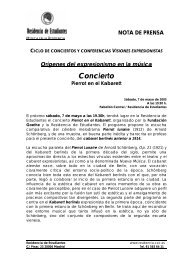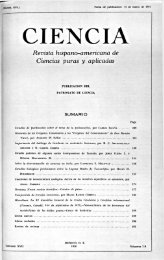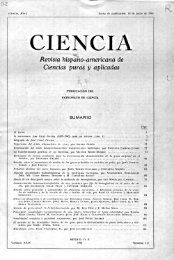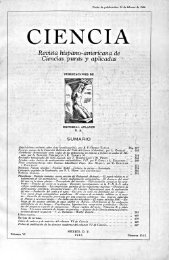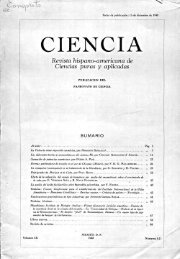C I E N C I A - Consejo Superior de Investigaciones Científicas
C I E N C I A - Consejo Superior de Investigaciones Científicas
C I E N C I A - Consejo Superior de Investigaciones Científicas
Create successful ePaper yourself
Turn your PDF publications into a flip-book with our unique Google optimized e-Paper software.
CIENCIA<br />
vos. En el curso <strong>de</strong> observaciones efectuadas durante<br />
SO años en esa área, nunca vio otras especies<br />
anidando, y sus observaciones fueron confirmadas<br />
in<strong>de</strong>pendientemente por otros pescadores.<br />
John Werler (1951) publicó un artículo sobre<br />
el <strong>de</strong>sove <strong>de</strong> una lora en Isla Padre. Carr<br />
(1961) citó dos nidos <strong>de</strong> la Isla Padre, en la<br />
vecindad <strong>de</strong> Little Shell, basado en fotografías<br />
<strong>de</strong> hembras anidando, tomadas por Jesse Laurence,<br />
ingeniero <strong>de</strong>l Condado <strong>de</strong> Nueces. Uno<br />
<strong>de</strong> esos nidos ya había sido citado por Werler.<br />
Sin duda. Isla Padre, no es una localidad importante<br />
<strong>de</strong> anidación <strong>de</strong> tortugas marinas, puesto<br />
que sólo me ha sido posible señalar otros<br />
tres nidos <strong>de</strong> la lora, sobre la base <strong>de</strong> mis entrevistas,<br />
verbales o por correspon<strong>de</strong>ncia. El<br />
Sr. Laurence me ha hecho saber, que observó<br />
una tortuga semejante a las dos que fotografió<br />
anidando a mediodía en la Barra <strong>de</strong> Corpus<br />
Christi, pero por <strong>de</strong>sgracia no anotó la fecha,<br />
ni tomó datos <strong>de</strong> este hecho. Rod Moore, un<br />
piloto local que ha volado en aviones ligeros<br />
durante muchos años en el área <strong>de</strong> Corpus<br />
Christi, recuerda haber visto dos pequeñas tortugas<br />
anidando en la playa, en un día caluroso<br />
y <strong>de</strong> fuerte viento, aproximadamente en mayo<br />
<strong>de</strong> 1938, cuando volaba a poca altura para localizar<br />
un automóvil entre Big Shell y Little<br />
Shell, en Isla Padre.<br />
Probablemente esta preferencia por ciertos<br />
sectores <strong>de</strong> la playa como lugares <strong>de</strong> anidación<br />
sobre otros, pue<strong>de</strong> explicarse por las características<br />
<strong>de</strong> los sedimentos y <strong>de</strong> las corrientes litorales<br />
en estos puntos nocíales. De acuerdo con<br />
Alan Lohse (1959):<br />
"Big aml Little Shell are primary and secondary<br />
nodal poinls respectivcly of coastal drifting processcs acting<br />
along Ihe Texas Gulf beaches. The áreas of accumulalion<br />
of sand and shell <strong>de</strong>tritus are shifted in short tenn<br />
scasonal fluctuations and long tcrm annual fluctuations".<br />
Hay que hacer hincapié, en que las condiciones<br />
tle la playa en estas localida<strong>de</strong>s son tan<br />
<strong>de</strong>ficientes que los automóviles particulares raras<br />
veces pue<strong>de</strong>n atravesarlas. En consecuencia,<br />
también es posible que las tortugas hayan sobrevivido<br />
en tales zonas <strong>de</strong>bido a las escasas activida<strong>de</strong>s<br />
humanas. Las <strong>de</strong>sovadoras actuales representarían<br />
por consiguiente, sólo el remanente<br />
<strong>de</strong> una población <strong>de</strong> tortugas en otro tiempo<br />
más dispersa.<br />
DESOVADEROS DE L A L O R A E N E L SUR DE<br />
T A M A U L I P A S<br />
En 1958, cuando me hallaba visitando al<br />
Sr. Francis McDonald, me asombró escuchar<br />
107<br />
que cerca <strong>de</strong> su campo <strong>de</strong> pesca anidaban |>equeñas<br />
tortugas durante mayo y junio, en tal<br />
abundancia, que cada año venía un árabe con<br />
40 ó 50 burros y empacaba en sacos <strong>de</strong> yute<br />
gran<strong>de</strong>s cantida<strong>de</strong>s <strong>de</strong> huevos para ven<strong>de</strong>rlos en<br />
Tampico. Al parecer, los ribereños emplean<br />
tanto el nombre <strong>de</strong> "tortuga" como el <strong>de</strong> "cahuama",<br />
para referirse a la lora.<br />
El tamaño <strong>de</strong> los ejemplares era indicio <strong>de</strong><br />
que éste constituía un <strong>de</strong>sova<strong>de</strong>ro <strong>de</strong> lora, pero<br />
la comprobación <strong>de</strong>finitiva no fue posible hasta<br />
el otoño <strong>de</strong> I960, cuando logré obtener un caparazón<br />
<strong>de</strong> 59,5 cm <strong>de</strong> longitud, <strong>de</strong> una lora que<br />
fue capturada al anidar. De acuerdo con Carr<br />
y Caldwell (1956) este ejemplar <strong>de</strong>be haber pesado<br />
unos 25 Kg. El Sr. Juan González Galván,<br />
<strong>de</strong> Rancho Nuevo me comunicó que el peso promedio<br />
<strong>de</strong> las hembras al anidar es <strong>de</strong> 35 Kg. He<br />
visto fotografías <strong>de</strong> ejemplares gran<strong>de</strong>s, con un<br />
peso <strong>de</strong> 45 Kg, capturados por Bob Gulley frente<br />
a las costas <strong>de</strong> Texas.<br />
Casi al mismo tiempo, la Sra. Eldridge,<br />
<strong>de</strong> Beaumont (Texas) me facilitó amablemente,<br />
y me permitió copiar, una película <strong>de</strong> 8 mm<br />
sobre la secuencia <strong>de</strong>l <strong>de</strong>sove <strong>de</strong> una lora. Con<br />
respecto a esta película, la Sra. Eldridge escribe:<br />
"The pictures were ma<strong>de</strong> Friday, May IS, 1960 and<br />
it was between 10:00 and 11:00. When we first went out<br />
early in the morning lo fish in the surf, we didn't notice<br />
any turtles but on our way back to camp (Campo Andres)<br />
some lime between 9:30 and 10.00 one of the<br />
gui<strong>de</strong>s saw one, and then we saw two more. We rushed<br />
lo get our cameras at the camp and by the time we<br />
returned the turtles had gone into the Gulf. We drove<br />
on and soon saw one just coming out of the water. She<br />
went just below the sand dunes and started her nest.<br />
From the time she came out of the water, prepared her<br />
nesi, laid her eggs and covered Ihem. it took no longer<br />
than 30 minutes. Earlier in the day it was calm, but<br />
around nine o'clock it got extremely windy and Mr. Mc<br />
Donald, ihe camp owner, told us that turtles always<br />
chose such weather so that the wind would blow the<br />
sand and cover their tracks. We left the next day and<br />
from the plane, turtles cowl be seen all along the beach"<br />
Al interrogar al Sr. McDonald, se mostró<br />
reacio a estimar el número <strong>de</strong> tortugas que anidaron,<br />
pero dijo que fueron varios miles, y afirmó<br />
que con frecuencia <strong>de</strong>s<strong>de</strong> 15 Km al norte<br />
<strong>de</strong> su campo, hasta unos 8 Km al sur, siempre<br />
estarían a la vista por lo menos cinco tortugas<br />
anidando, entre las 9 <strong>de</strong> la mañana y las 2 <strong>de</strong><br />
la tar<strong>de</strong>. Uno <strong>de</strong> los guías <strong>de</strong> pesca, con experiencia<br />
<strong>de</strong> ocho años en Campo Andrés, afirmó<br />
que las tortugas anidan por cientos en las proximida<strong>de</strong>s<br />
<strong>de</strong>l Campo y por miles cerca <strong>de</strong> Rancho<br />
Nuevo.<br />
La ubicación y tamaño <strong>de</strong> la zona <strong>de</strong> anidación<br />
<strong>de</strong> la lora, fue probada sin duda alguna<br />
por una asombrosa película <strong>de</strong> 16 mm tomada<br />
por el Ing. Andrés Herrera, <strong>de</strong> Tampico; los biólogos<br />
marinos están en <strong>de</strong>uda con él por regis-



